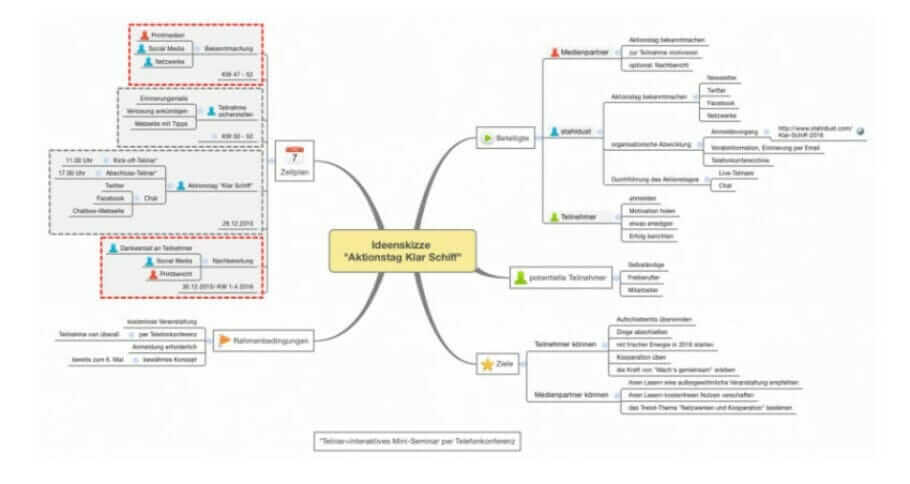For their successful, good life Information you really need: Government-funded publisher, awarded the Global Business Award as Publisher of the Year: Books, Shops, eCourses, data-driven AI-Services. Print and online publications as well as the latest technology go hand in hand - with over 20 years of experience, partners like this Federal Ministry of Education, customers like Samsung, DELL, Telekom or universities. behind it Simone Janson, German Top 10 blogger, referenced in ARD, FAZ, ZEIT, WELT, Wikipedia.
Disclosure & Copyright: Image material created by Verlag Best of HR – Berufebilder.de®.
Founding a start-up: recognizing trends & finding business areas [+ checklist]
By Simone Janson (More) • Last updated on October 05.11.2023, XNUMX • First published on 31.01.2020/XNUMX/XNUMX • So far 5397 readers, 2289 social media shares Likes & Reviews (5 / 5) • Read & write comments
At the beginning of every start-upFoundation there is a really good business idea that can also be used in crises for sure remains. But how do you find them? An overview.

- How to find a crisis-proof idea
- Start with yourself
- What are my interests?
- What does your customer want?
- A question of empathy
- Above-average success demands above-average performance
- Checklist: How to find out what customers want
- Trends - tomorrow's customer needs
- Mega trend age - cosmetic products for the elderly
- Do your own research
- Patent searches are worthwhile
- 4 tips: Look for specific information in your industry
- 10 tips: You should specifically determine this industry information
- 4 tips: Conduct your own survey
- What do the general trends look like now?
- Watch values
- Customers become unpredictable
- 5 Techniques: How to Turn a Trend into a Really Good Idea
- 7 reasons: Chances and risks of your business idea
- 3 tips: How to prepare for crises
How to find a crisis-proof idea
Great, now you are motivated to start your own business, despite all the prophecies of doom and difficulties. But something is still missing: A really good business idea. One that ignites and customers confident even in difficult times.
And how do you like it? By doing the following two steps follow: Think about what you can do best yourself. And then look for ways to leverage your skills to the benefit of customers by looking for appropriate economic trends. Doesn't sound that complicated, does it? But one after anonther.
Start with yourself
First of all, you should narrow down your start-up idea to certain areas. Think about what you are good at, and what things you are particularly good at. After all, it's no good if you know that the IT sector offers particularly good start-up opportunities, but you'd rather go with them People want to work. Conversely, you can hardly become self-employed in geriatric care if your real talents are in the field of craftsmanship. So what are your specialties?
What are my interests?
- Which situations interest me, which activities do I enjoy?
- What do I like talking to friends about?
- For which activities would I like to have more time?
What skills and talents do I have?
- What is easy for me and why?
- Where have I been successful?
- What do others trust me?
- Which of my talents could I use more than before?
What particular knowledge and skills do I have?
- What have I learned?
- What tasks do I do in family and free time? What jobs did I have?
- What could / can I do and do I like?
What qualities can I briefly describe myself with?
- e.g. my special characteristics, my personal characteristics:
- eg I can listen patiently
- eg I'm friendly
- eg I have a lot of understanding for others
Because in the end your idea is also optimal merchandise it is important that you are completely convinced of the idea and have an idea of which product or service you are looking for merchandise. Only then can you also convince your customers and only then do you really believe in the success of your idea so much that you put all your energy into it. Most really good business ideas arise in this way from the everyday life of the entrepreneur.
You have children and at first you only want to resell the clothes that have become too small on Ebay, in order to Money to save. This works surprisingly well because you accidentally discover a gap in the market. Over time, the idea of an online shop for used children's clothing developed from this.
What does your customer want?
Unfortunately, your enthusiasm for your own idea is only half the battle: the other half is the question of customer benefit. Because other people will only buy your product if they get an advantage from it. For example, customers buy washing machines because they want to get their laundry clean. Or cars to get around. That is the customer benefit. And customers usually don't want products: they want them Solutions!
But people don't just buy what they absolutely need: Take a look at the boom in organic products in the supermarket, for example: Although they are more expensive than conventional foods, they promise more enjoyment and Health. Or the IPhone - most people could also have a much cheaper phone, but the IPhone gives a certain image to its owner and that is the usefulness of this device for many customers.
A question of empathy
Forget what you think about your product and put yourself in the position of your potential customers: What will the customer be interested in about your goods? How will your goods benefit the customer? How will he use them? Which needs can you satisfy with your product?
For these reasons, you always have to tailor your goods to the needs of your customers! And since there is no way you can possibly know the needs of all people, you should focus on analyzing and fulfilling the needs, wants, and problems of a select audience of customers.
And for them you should then offer appropriate products and problem solutions, services and other innovations. In fact, you will be more successful in the long term if you specialize in selected products and customers instead of diversifying. It should be noted: Of course, specializing in certain goods entails risks: if a product does not sell well, you can always sell other products if there is a wide range on offer. But: diversification can fast lead to getting bogged down. If you have time and money in the distribution of five products invest, each area accounts for only 20 percent.
Above-average success demands above-average performance
However, you cannot expect above-average performance and success if you are not willing to do something for it. This is because you are signaling to your customers that you cannot deal intensively with the wishes of your customers. If you but your Energy If you focus on a single product (or range of products), you're more likely to use it successfully because you deliver unrivaled top performance and are perceived much better by your customers.
If you competently If you offer what your target group really wants, you will achieve numerous competitive advantages over your competition. Because if you don't offer anything special, your customers see you as just one of many providers. The only difference then compared to your competitors is the price.
If, on the other hand, you only ever undercut your competition in a constant price war because you are trying to reach your customers with the lowest price, you can only do this in the long term verlieren; because this Strategy must ultimately mean that you can no longer work profitably. On the other hand, if you offer the customer a special benefit, they are willing to pay more for it. So create a gap in the market and focus on the wants and needs of your customers.
Checklist: How to find out what customers want
Keep tight Contact with your customers so that you always know what they want. For example, create a forum on your website or organize regular customer meetings. Ask You always target the needs, expectations and wishes of your customers. Check the regularly satisfaction your customers with products and service. Remember: Criticism can also be positive and help make things better. Finally, focus on your services that increase customer value, such as quality and service, environmental friendliness, profitability, responsiveness to customer wants and needs, fast delivery, and Performance, security etc.
Trends - tomorrow's customer needs
When looking for a really good business idea, you shouldn't just rely on what (potential) customers say to you today, but above all look specifically for trends. Because if you know what your customers want to buy tomorrow, you can adapt your range of goods to the needs of your future customers today and thus survive in the market for the long term.
Research trends and collect them ideasthat you develop from it. In a brainstorming process, write down how you can benefit from this trend and how you could adapt to it - your business concept draw up you later! Here's an example:
Mega trend age - cosmetic products for the elderly
You want to sell cosmetics and realize that this is a trend Age and active aging. How many Companys recognize the opportunity to offer targeted products that are tailored to more mature people. And you think about your offer:
- Are older people a potential target group for my goods? Can this result in a new market segment for cosmetic products?
- What needs, expectations and wishes does this affluent target group have of cosmetics? How do I deal with it and what does that mean for my range of goods?
- Can I market cosmetic products with keywords such as “activity in old age”?
But how do you find such trends? A possibility that larger companies like to use: They commission a market analysis. However for you as a small business owner these are usually the Costs such an analysis is usually too high.
But you also have the opportunity to analyze trends and customer needs in advance by becoming active yourself. It may take you some effort, but it's usually less effort than if you're unsuccessful afterwards. The following Methods are ideal for small business owners:
Do your own research
You can find a lot of information on current and future trends quickly and cheaply in the WorldWideWeb. If you search specifically here, you will quickly see that some topics are repeated over and over again.
Certain questions crop up again and again, for example in knowledge portals such as Wikipedia, the internet sites of magazines or as press releases from companies or associations. In this way you get a good overview of which topics are currently being discussed or even treated as future topics.
Look specifically for trends in search engines. How about the following keywords, for example: “Trend + Society' or 'Trend + 'your product group'. Or do not enter “trend” but “development”, “Future”, “opportunities, risks”, “Innovation” or “business idea”. And do not only read the front search terms, but also found them on the back pages. Only when you believe that there can be nothing more new on a topic can you stop.
Also a good starting point: Online-book markets. Here you can find out which titles and topics are at the top of the list. You can also call up the readers' opinions directly under the respective title.
There are also forums, knowledge portals and blogs that deal with specific or general topics. In forums you can discuss topics, ask questions, etc. For example, there are forums for health, Marketing, Business Start-up and many others where you can find user discussions, news, appointments etc.
Visit sites where you suspect potential customers or specialists who can help you with information and take an active part in the discussion. You get a good sense of what is on the other people's minds. You can also make a name for yourself in the scene if you write informative and helpful articles yourself, because that's how you make yours Competencies publicly proven.
You should also pay close attention to which topics are reported particularly frequently in newspapers, magazines and television, because these are current or future trends.
You can also find out which areas are particularly funded by municipalities, federal and state governments: For example, money is currently flowing into renewable energies, childcare, new technologies, innovation management and business start-ups - these are the areas that will be supported and brought forward in the future should.
Patent searches are worthwhile
Do you want to sell innovative products? The German Patent and Trademark Office offers unused patents for commercial use: http://www.dpma.de/. The InnovationMarket also offers exchanges both for companies that want to present themselves for a suitable innovation and for innovations that are looking for a user: http://www.innovationmarket.de
In addition, you can Internet search specifically for current market studies or figures on economic development with meta search engines and often download them free of charge.
4 tips: Look for specific information in your industry
However, general trend information may only help you to a limited extent and you need specific information about yours Industry. For example, if you want to sell a certain technical device, you are probably less interested in long-term social trends: You want to be able to assess whether the device will sell. And for that you need specific information.
- First point of contact: The chambers of industry and commerce of which you as a trader are already a member. They often provide information on trends in various industries or studies on market developments. Just look for events, advice and online information from your or other chambers of commerce. In particular, the large chambers such as Hamburg, Stuttgart, Cologne etc. also offer extensive information online.
- The professional associations often know more about current developments in the respective industry or can name experts. You can often get such information even if you are not a member.
- Finally, take a look at the competition. Get an overview of what other entrepreneurs in your industry are doing with a similar product segment or service. You can get a very good first impression of a company on the website, for example. You may also find yourself missing certain offers that almost everyone else has. Or you discover that certain services are not yet available on the market.
- Look for press releases from your competitors on your competitors' websites or on special PR portals, from which you can find further information. You will also find the latest trends in your industry in trade magazines. Another possibility: corporations such as GmbH's have had to publish their annual financial statements in the central company register since 2007. You can therefore search specifically for the sales of your competitors, provided it is a corporation.
10 tips: You should specifically determine this industry information
What information do you actually need? In the jungle of tips, you can lose track of things. This checklist helps you find the right information.
- How fast is the market? What influences are there on the market (innovations, know-how advantage, new competitors)? Are there seasonal and / or economic fluctuations? What developments do you expect in the future?
- Is it easy for newcomers to establish themselves in the market? Are there any barriers to entry?
- How many competitors with similar products or services are there on the market? Can you name your three main competitors?
- How has the number of your direct competitors developed in the last 3 years? How many direct competitors started the market last year with a similar idea - and how many gave up?
- If you find out about the sales of your competitors: How have the sales of your competitors developed (increased, remained the same, decreased)? Do you know the reasons for that? Which offers generate the highest sales?
- Can you notice changes in the behavior of consumers, retailers and manufacturers?
- Who are your typical customers of your competitors and what purchasing power do these customers have? Which sales are generated with which customers?
- What wishes, expectations and needs do customers have, what services do they expect? And what really makes the customer happy?
- Can you open up new target groups for your goods? Where do you see a niche for your offer?
- Can you assess the market position of your competitors compared to your own company in terms of product range, quality, service, price, image and marketing?
4 tips: Conduct your own survey
If you have already narrowed down your target group, you can carry out a survey on your own. There are various options for this ways to: You can simply call potential customers, address them on the street. You can hire a professional pollster. Or you can use the medium in which you will work in the future: the Internet. For example, you can set up your own site where other people can answer related questions. Or you organize a survey in a suitable forum, for example in a group on Xing. Here's how to do it.
- You will probably need the moderator's permission to do this. It is important in such a survey that you precisely define the group of people to be surveyed and the topic. But: The group of people must be representative enough so that you can draw conclusions from it. You must also provide precise information about the meaning and purpose of the survey.
- Make it clear that the evaluation is anonymous and that you will not use the data for any other purpose. You should also formulate the questions in an understandable and non-suggestive way: yes and no answers are easier to answer and faster to evaluate. It should take the respondents no more than 10 minutes to work through your questionnaire. You may be able to reward your willingness to participate with a small thank you.
- And you should keep questioning your customers regularly in the future as well. For example, find out regularly about the wishes and needs of your customers and tailor your offer accordingly.
- For example, you can determine under which conditions your prefer the low price or the high quality or whether you prefer the technical variety or the simple usability of the product. In this way, you can estimate at an early stage which criteria your customers will use to make their purchasing decision in the future. And the more familiar you are with the world of your customers, the more confidently you can plan the future.
What do the general trends look like now?
Of course, it is always difficult to look into the future: Nobody can give an exact forecast of which ideas will be asked for now. But experts assume that our markets will change from subsistence to existential markets in the next ten to 20 years.
Values are directly linked to how people think, feel and act. Value change processes shape attitudes, desires and judgments. Values are existential in people's lives Significance, they are omnipresent, yet not visible. Values are applied intuitively as far as possible and are a more or less unconscious but enormously important foundation for life and consumer decisions. Values are subject to constant change due to trends and other social change processes. A lot can be learned from the change in values about the change in lifestyles and consumer needs. Values should therefore not be underestimated as a basis for making decisions about consumption and lifestyles. For this reason, it is advisable for companies in particular to deal with values and value change processes. Because with a view to people's understanding of values, a lot can be done about that Behavior and the needs of the global markets are learned.
Watch values
This means that we achieve a large part of our added value by the fact that consumers no longer only satisfy necessary needs, but pay more attention to quality of life when consuming. It also means that customers are less and less willing to spend money on unnecessary products or in bulk to buy inferior goods. No longer cheap at any price and greed is cool, but selection is required.
This is exacerbated by economic crises: people assume that they will have to slow down in the next few years. But it would be naive and too short-term if we believed in the face of this that only the price would react in the future.
On the contrary: people spend their money in a more targeted manner. They are again limited to the essentials: simplicity and quality of life instead of abundance, self-made and individual items instead of mass products. This change of heart among consumers was made possible by the Internet: producers can now also sell niche products in small numbers and send them worldwide. This explains, for example, that regional products are becoming export hits.
Customers become unpredictable
So customers will no longer just spend their money on anything, but only on the things that are necessary or that make life better. Customers have become more critical: They network via the Internet to Opinions exchange information about the company and the product. Entrepreneurs who want to stay in the market in the future would do well to network with their customers: Advertising won't work in the future, which is what matters Communication. Modern customers want to be taken seriously feel.
In the age of mobility and frequent moves, more and more customers will spend their money precisely on this: To simplify their mobile life. Be it through appropriate technical aids and software or simply by buying fewer things in order to be more mobile - and then spending your money on corresponding life-facilitating services. This can be, for example, consulting services that deal with certain problems such as the Career choice help. Or that can be services that - also an important point in difficult times - convey a feeling of security, such as financial advisors.
Another important trend, which is becoming more and more important for all entrepreneurs, is the eco-trend: From organic products at discounter to designer for eco-fashion to eco-emergencyebook the green wave has long since reached all industries. However, eco is not synonymous with abandonment of the world and idealistic transfiguration of nature: Today's eco-friendly products are highly technical and want to consciously enjoy life. Anyone who wants to stay on the ball as an entrepreneur will probably have to jump on the eco train sooner or later.
5 Techniques: How to Turn a Trend into a Really Good Idea
When you have obtained enough information about industries and trends and have thought about it extensively, it becomes concrete: it is about converting the large amount of information into a concrete idea. Your ideas as an entrepreneur are in demand here. Then: creativity is not only important in so-called creative professions, but affects all areas of your daily work. Good ideas that solve problems, optimize your product or service and take you further are important prerequisites for your success.
Good ideas are like pulp that gradually takes hold: First the core is there, then there is this and that. Ask other people for their opinion too. But what if you just don't have a new idea despite the amount of ideas? Then you can systematically give your creativity a boost by simply trying out a new perspective or using other techniques to increase your creativity.
1. Mind map
This Technology is ideal if you want to offer special goods that are specifically tailored to specific customers. It's traditionally done with paper and pen - but now also with a computer. In the middle of a large sheet of paper, write the subject in capital letters, for example “My shop's product range”. Circle it.
Now make multi-colored branches - each branch is a new keyword that comes to mind. Make further branches from each keyword. For example, the first keyword is “technical products”, then you become more specific and write on “computers”, “laptops”, “software” - you soon notice that you get the most ideas in a certain area.
2. List of characteristics
Usually the wheel is not reinvented with good ideas: Most successful products are modifications or improvements of existing products. So if you want to offer innovative services and products, you should use this technique:
Make a note of the most important characteristics of an already existing product or service: shape, size, design, material, color, task, price, etc. to make a service better or more attractive? In this way you get ideas for designing your range of goods.
3. Brainstorming
Here you should simply let your thoughts run free spontaneously and uninhibited: Such a brainstorming session usually lasts 20 to 40 minutes. Write down a large number of ideas on a topic or problem.
Don't rate anything yet, the first thing to do here is to collect your ideas. If at this stage you already have criticism of your idea to practice, will not come out of it.
4. Morphological box
With the help of the morphological box, all conceivable solutions to a problem are to be compiled systematically. The problem is your founding idea: First of all, all the decisive sub-problems (customer benefits, own resources, prices, competition, etc.) must be determined.
For the sub-problems different solution alternatives are worked out and noted next to each other. Individual solution variants for each subproblem can now be combined to form complete solutions. From the various possible combinations can then select the best.
5. Six hat thinking
- This method is a little more playful, but it is a good way to look at your idea from different angles. Put on one of six colored hats as you wish - one after the other, of course. Each color represents a particular mindset. Take the relevant opinion and write it down. The color symbolism is:
- White: objectivity, neutrality. Information is collected without rating. It only counts facts and numbers, no emotions, judgments and personal opinions.
- Red: personal feeling, subjective opinion. All positive and negative feelings are allowed; no justification! For example, think about how you would react to positive and negative customer feedback!
- Schwarz: Factual arguments that express doubts, concerns, risks, not feelings! For example, imagine a critical customer.
- Yellow: objective, positive qualities, ie chances, pluses, hopes and goals.
- Green: new ideas, alternatives, provocation and contradiction, no matter how crazy or unworkable the ideas are. No critic!
- Blue: control and organization, keeping track, bringing results together.
6. Osborn method
With this method, you can analyze a problem by asking specific questions. This is best done in writing. Name your problem, for example, "What product do I want to sell" and then ask yourself a few questions. Even if the questions seem a little strange to you, they help you see your idea from different angles.
- What can the customer use this product for?
- Are there any other similar products?
- Which properties can be redesigned? Which conditions can be changed?
- Can I enlarge, add, reduce, remove or similar something?
- Can I change the order or structure?
- Can the idea be turned to the opposite?
- How can I connect product and customer?
5. Just do something different
Sometimes it is enough just to change your perspective on something to come up with a new idea. For example, you can change the question. What is your initial question so far? Which aspect of the topic has been in the foreground so far?
If you find a different initial question, bring a completely new aspect of the topic to the fore. You can even reverse the question. Now you may think of a lot of things that you shouldn't be doing - and that will give you numerous ideas on how to do it.
7 reasons: Chances and risks of your business idea
Unfortunately, it is not enough to recognize trends in good time and implement them as an idea. You must also be aware of the opportunities and risks of your idea and incorporate them accordingly Planning include. Because unfortunately there are many reasons why your business start-up can fail. These are the most common reasons for the failure of a business start-up:
- Planning errors: Missing corporate strategy, getting bogged down instead of concentrating on target groups, incorrect or inadequate planning, planning that is too optimistic, planning does not provide a basis for actual action, no coordination of the actual values with the planned values.
- Insufficient information about customer benefits: customer wishes not (sufficiently) recognized, demand estimate too optimistic,
- Competitive behavior underestimated, etc. Financing deficiencies:
- Incorrect assessment of the capital requirement, incorrect liquidity planning, excessively high start-up costs, etc. Deficiencies in qualifications (for example, low professional competence, lack of entrepreneurial thinking and acting as well as a lack of commercial knowledge.
- Insufficient controlling: Insufficient use of the accounting system and of the evaluation and planning options.
- Family problems: The partner does not agree with the project or does not support it sufficiently.
- Events in the environment: changes in purchasing behavior, trends that are different than expected, obsolescence of products or parts of operating and office equipment due to technical progress, new legal regulations, changes in municipal planning, etc.
3 tips: How to prepare for crises
But what can you do to be prepared for such uncertainties? One thing is clear: of course, you cannot know in advance everything that can happen and be prepared for it. Trends, for example, rarely develop in a straight line and are therefore difficult to predict.
Nevertheless, you can prepare yourself for eventualities: Here elements from the so-called scenario technique help: Develop parallel strategies so that as soon as a development is recognizable, you can find the appropriate basicConcept have available.
- In one scenario, calculate that your business idea is going well. That is the ideal case, you don't have to do anything? But. For example, if your goods are really selling to travelers, you should make plans to expand: would you expand the range of goods or increase the amount sold? In both cases you have to increase the storage capacity. Or would you, as a service provider, hire someone with a corresponding additional effort?
- But also calculate a scenario in which it does not work at all. Even then, you have to react quickly: What do you do in such cases with the excess goods, for which storage costs may arise? How do you change your marketing strategy in order to save your idea after all - for example by changing the prices or focusing on a new target group? What do you do with staff that you may have already hired?
- But you should always also think about the competition: Of course, your competitors are also constantly on the lookout for new trends and ideas. Therefore, you should always ask yourself how you can persuade your customers to buy from you and not from a competing provider with similar goods or services. Low prices are only a means, because in the long run there will be no winners in the price war. What you need is a unique selling proposition, a so-called Unique Selling Position (USP). Because in this way you bind customers to your company and create a recognition value that sets you apart from the competition.
Here writes for you
 Simone Janson is publisher, Consultant and one of the 10 most important German bloggers Blogger Relevance Index. She is also head of the Institute's job pictures Yourweb, with which she donates money for sustainable projects. According to ZEIT owns her trademarked blog Best of HR – Berufebilder.de® to the most important blogs for careers, professions and the world of work. More about her im Career. All texts by Simone Janson.
Simone Janson is publisher, Consultant and one of the 10 most important German bloggers Blogger Relevance Index. She is also head of the Institute's job pictures Yourweb, with which she donates money for sustainable projects. According to ZEIT owns her trademarked blog Best of HR – Berufebilder.de® to the most important blogs for careers, professions and the world of work. More about her im Career. All texts by Simone Janson.









Post a Comment